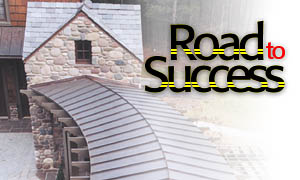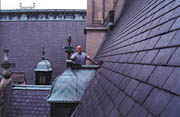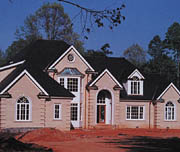A Little Good News: Start-up Roofing Company Follows Road to Success


And so we introduce you to The Century Slate Co., Durham, N.C. In business for five years, Century Slate specializes in copper, slate and tile roofing, both new construction and historical renovation. President Mike Tenoever got his start working for another copper and slate roofing company in Ohio. While he was employed there, he and one of the owners opened an office in Cincinnati, which allowed Tenoever to have a hand in all facets of the operation.
After gaining knowledge and practical experience, Tenoever decided to strike out on his own. He had signed a non-compete clause with his previous employers for a certain geographical range, so he chose to move to Raleigh, N.C. Tenoever had done work there after Hurricane Fran hit in the fall of 1996. He liked the area and there were lots of opportunities to do slate jobs.
“I bought a truck, some ladders and various other pieces of equipment,” says Tenoever. “I made some fliers and passed them around in some of the older neighborhoods that were in need of restoration work. On occasion I would see someone out in their yard and was able to talk to them.” After selling a couple of jobs, Tenoeover was helped by word of mouth. He worked alone for six months, and then was able to hire two of his brothers, Pat and Joe. Pat has since moved back to Ohio, but Joe remains as the company’s vice president. Century Slate now has 25 employees, and Tenoever plans to continue expanding.
Getting established, “has been a learn-as-I-go process,” says Tenoever. “I do not have a significant amount of (formal) business training. I think the practical knowledge I have been able to acquire from professional accountants, bankers, lawyers, etc., is difficult to learn unless you are in a situation of ‘need to know.’”
The company has a complete sheet metal shop with Schectl computerized sheet metal brakes, Knudson roll formers, a Schroeder power shear and many other pieces of related equipment. “We fabricate everything from drip edges to decorative finials,” explains Tenoever. “We also sell copper and other metal mirror frames. The name of this business is Rainy Day Designs. In our search for things to do on rainy days, we have come up with some great designs. We are able to acid wash and etch designs in the frames to create different looks for similarly designed mirrors.”
It seems, however, that Century Slate is not seeing too many rainy days. Tenoever has not noticed an economic slowdown. “I still feel comfortable about the economy,” he says. “If it slows down, we’ll just have to work a little harder to get work.”
In the mean time, Tenoever recently started a third business called CSC Sheet Metal, and has invested in a wide range of new sheet metal equipment. The new additions include: 5- and 6 1/2-inch round gutter machines; 3- and 4-inch square and round downspout machines; 5- and 6-inch K-style gutter machines; roll forming equipment for standing seam; a radius former for standing seam; 10-foot powered rolling machines for custom-sized downspouts and various other uses; computerized brakes; and power shears.
Another exciting new addition is an ESAb water jet machine that Tenoever saw at the FabTech show in Chicago. “The water jet is capable of cutting up to 8-inch steel, wood, glass, marble, anything,” explains Tenoever. “It cuts with precision only matched by a laser machine.” The machine allows for more intricate, yet less labor-intensive designs.
In short, “We have the ability to custom fabricate for almost all sheet metal needs. We provide free delivery in North Carolina and surrounding areas,” says Tenoever. In addition, “We have a full line of custom decorative collector boxes, metal cornice, chimney caps, finials, as well as standard items like downspouts, elbows, hangers and gutters.”

Projects
Oh sure, Century Slate has all of these cool new toys, but what have they actually done with them?A lot.
The company’s many jobs include upper-end residences, churches, universities and state projects. One recent project was the Lamar House, built in the late 1800s and owned by the state of North Carolina. Century Slate removed the existing roof cover and installed new, North Country unfading black slate. Crews used lead-coated copper in all of the valleys. In addition, they replaced the flat-lock, soldered copper roofs. Custom lead-coated copper ridge roll was fabricated and installed to match the original design, while Yankee-stop gutters were re-built and lined with new copper.
Century Slate also recently finished the restoration of Alderman and McKiver halls at the University of North Carolina Chapel Hill. This project involved the total restoration of existing box gutters, chimneys, chimney caps, wall and various other flashings, and the replacement of a 22-foot Corinthian-style wood column. “We had to jack the roof up and remove the column,” explains Tenoever. “The column was then milled from solid redwood and reinstalled to original specifications.”
Tenoever adds that the company has just secured a several hundred thousand dollar contract with Duke University for the installation of lead-coated copper standing seam panels, gutters, downspouts, etc. In addition, “We are preparing to begin a project at UNC Kenan Center in Chapel Hill that includes lead-coated copper coping and the replacement of slate valleys. There will also be coring through the parapet walls soldering new metal to the existing, and creating overflows for the built-in gutters – all of which is 70-feet high.” Century Slate will subcontract out the waterproofing work, which entails removing and replacing all of the caulked joints on the entire building.
The Biltmore
Century Slate has completed several projects at the historic Biltmore Estate in Asheville, N.C. The centerpiece of the estate is the Biltmore House, construction on which began in 1889. According to the estate’s Web site, owner George Vanderbilt used two of the most distinguished designers of the 19th Century for the project: architect Richard Morris Hunt and landscape designer Frederick Law Olmstead. When the house opened in 1895, it was not yet complete – work went on for years. Its 390-foot fa?e has more than 11 million bricks. The massive stone spiral staircase rises four floors with 102 steps.“Most of the copper flashings on the house are original and in need of repair,” says Tenoever. “We have replaced some of the valleys behind the decorative dormers. Most of the work is competed on a need-be basis due to budget constraints.”
The roof is challenging because of its structure, especially the near-vertical pitch. “There is no wood decking on the Biltmore,” explains Tenoever. “There is angle iron installed 6.5 inches on center from eave to ridge. Each slate is tied with copper wire to the angle iron. We have had to be a little more creative for accessing the problem areas.” In order to access the rear of the roof, crews had to carry 40-foot ladders up the spiraling staircase on the inside of the mansion to a deck on the outside in the rear of the building. Slates were removed at the eave and workers inserted the ladders in between the angle iron.
Once this was accomplished, work could begin. Crews removed slate from around the decorative copper dormers, and then pried them out a bit from the roof. They then installed custom-fabricated 20-ounce lead-coated copper radius valleys behind the dormers. “The valley metal had worn through from many years of water beating down, but the dormers themselves are in excellent condition,” says Tenoever.
At the time of this interview, Century Slate was preparing to begin its next project on the Biltmore during the second week of April. Work includes removing the existing lead-coated copper standing seam roof from a 120- by 26-foot section. The first section of the roof includes built-in gutters, 13-foot long copper panels and then two sections of glass skylights. “We will first replace the standing seam and gutters with lead-coated copper,” says Tenoever. “We are also removing all 130 pieces of 5/8-inch-thick by 6-foot-long by 18-inch-wide glass. We have fabricated new lead-coated copper panes for the glass that will tie in to the standing seam roof, side walls and rear wall.”
Century Slate ordered 90 new pieces of custom-made glass to match the original. “The original glass has a milky color and all of the glass was rolled out by hand on the ground – as evidenced by the random dimensions and wavy look,” says Tenoever. “Through the years, pieces have been broken and replaced with glass that did not match exactly. The new glass will return the skylight roof to its original look.” In addition, “Below the skylights there was an ingenious copper channel designed to capture any water that may have leaked behind the panes. This water is then channeled out onto the standing seam roof,” says Tenoever. “We just have to verify that this existing system is still functioning properly.”
The Moral of the Story
What is the secret to Century Slate’s success? It’s not a secret, really. “Quality work, customer service and the willingness to just jump in and go,” says Tenoever. “Every facet of the business must be pumping at the same time. Once one lags behind, the rest of the business suffers. A business must market its product, sell its product, produce its product, ensure that the quality of its product is maintained, and, very important, don’t forget to get paid!”Looking for a reprint of this article?
From high-res PDFs to custom plaques, order your copy today!





